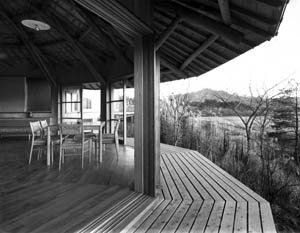Buy the Book
Crafting a Modern World: The Architecture and Design of Antonin and Noemi Raymond. At UCSB's University Art Museum. Shows though April 8.

This much is not in dispute: Antonin and Noemi Raymond were gifted and prolific architects. To live or work in any of their structures must be a rare pleasure. Their work makes contact with all that matters in early 20th-century architecture, with Frank Lloyd Wright and Le Corbusier. Their concerns are still very much our concerns: site specificity, ecological awareness, how space shapes daily experience, how buildings can humanize. The Raymonds undoubtedly deserve monographic treatment. Perhaps that in and of itself justifies a retrospective. Perhaps the two cannot be separated.
Here is what you will find if you go to the exhibition, though: Almost the entire museum is dedicated to the show, which winds its way at length through the space. The visual impact is either subtle or monotonous, depending on your mood; nearly the entire show consists of black-and-white photographs of buildings and monochromatic architectural drawings, although there are some watercolors, draperies, and rugs that add color here and there. In three dimensions, there are a few pieces of furniture that are in bad condition yet not old enough to have developed an aura, along with three excellent architectural models, which alone may well be worth the hassle of UCSB parking. If you want to get anything serious out of the show, however, you will need to be prepared to do some mental work akin to solving a Rubik’s Cube. You will need to go through the exhibition very slowly, reading the copious wall labels and then putting together a mental model of how each photograph fits with each drawing and how they then fit with the models on display. Undoubtedly, given the subtlety and appeal of the architecture in question, this would be a rewarding experience, but do you want to have to do the whole thing on your feet?
Being a university art museum is a tricky prospect. Shows that appeal to the general public or to the 18- to 24-year-old crowd, as a number of recent, fun UAM shows have done (Dan Eldon, for example, or Huichol yarn paintings) are not necessarily of scholarly value, and vice versa. With this show, the UAM seems to be doing its scholarly duty. The gallery was entirely empty on a recent Sunday afternoon, though; there were far more people looking at the tiny exhibition of Silk Road instruments. Even this former scholar-particularly if she had an extra 75 bucks and a coffee table-would rather buy the book.



